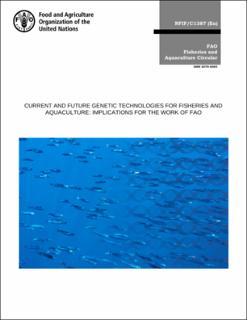| dc.contributor.author | Friedman, k.J. | |
| dc.contributor.author | Bartley, Devin M. | |
| dc.contributor.author | Rodríguez-Ezpeleta, Naiara | |
| dc.contributor.author | Mair, G.C. | |
| dc.contributor.author | Ban, N. | |
| dc.contributor.author | Beveridge, M. | |
| dc.contributor.author | Carolsfeld, J. | |
| dc.contributor.author | Carvalho, G. | |
| dc.contributor.author | Cowx, I. | |
| dc.contributor.author | Dean, G. | |
| dc.contributor.author | Glazov, E. | |
| dc.contributor.author | Leber, K. | |
| dc.contributor.author | Loftus, R. | |
| dc.contributor.author | Martinsohn, J. | |
| dc.contributor.author | Olesen, Ingrid | |
| dc.contributor.author | Soto, D. | |
| dc.contributor.author | Van Eenennaam, A.L. | |
| dc.contributor.author | Vigar, J.R.J. | |
| dc.date.accessioned | 2023-01-05T11:29:23Z | |
| dc.date.available | 2023-01-05T11:29:23Z | |
| dc.date.created | 2023-01-03T14:37:20Z | |
| dc.date.issued | 2022 | |
| dc.identifier.citation | FAO Fisheries and Aquaculture Circulars. 2022, (1387), . | |
| dc.identifier.issn | 2070-6065 | |
| dc.identifier.uri | https://hdl.handle.net/11250/3041181 | |
| dc.description.abstract | Within the last few decades, advances in genetic technologies have created powerful and efficient tools for fisheries stock identification, genetic improvement and domestication of aquaculture species and characterization of changes in aquatic life due to environmental or anthropogenic influences. Emerging genetic tools are improving our understanding of organisms in aquatic ecosystems, in terms of diversity, distribution, abundance, movement, function and adaptation, and are being applied in aquaculture facilities and across fishery and aquaculture value chains. In this study expert elicitation was used to examine and predict current and potential future (10 year) impacts of the application of these novel technologies in fisheries and aquaculture. Highlighting the need to prepare sectors for likely changes that will follow. All suggestions received were collated into themes, to provide a conceptual framework that partitions potential impacts, and calls for required action — action required on governance, management and practical application of these innovations at both a national and international level. | |
| dc.description.abstract | CURRENT AND FUTURE GENETIC TECHNOLOGIES FOR FISHERIES AND AQUACULTURE: IMPLICATIONS FOR THE WORK OF FAO | |
| dc.language.iso | eng | |
| dc.title | CURRENT AND FUTURE GENETIC TECHNOLOGIES FOR FISHERIES AND AQUACULTURE: IMPLICATIONS FOR THE WORK OF FAO | |
| dc.title.alternative | CURRENT AND FUTURE GENETIC TECHNOLOGIES FOR FISHERIES AND AQUACULTURE: IMPLICATIONS FOR THE WORK OF FAO | |
| dc.type | Journal article | |
| dc.description.version | publishedVersion | |
| dc.source.pagenumber | 68 | |
| dc.source.journal | FAO Fisheries and Aquaculture Circulars | |
| dc.source.issue | 1387 | |
| dc.identifier.doi | https://doi.org/10.4060/cc1236en | |
| dc.identifier.cristin | 2099835 | |
| cristin.ispublished | true | |
| cristin.fulltext | original | |
| cristin.qualitycode | 0 | |
